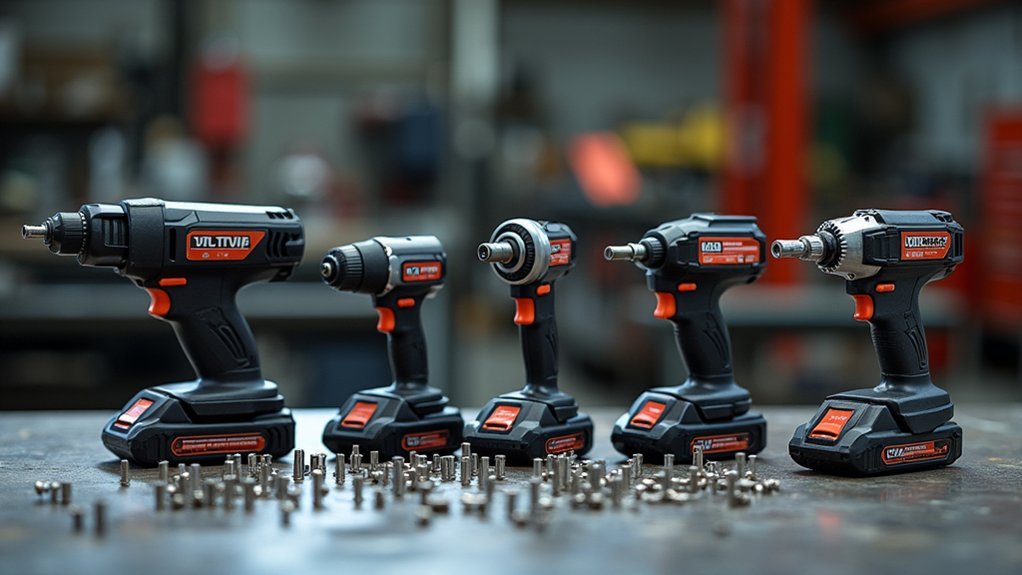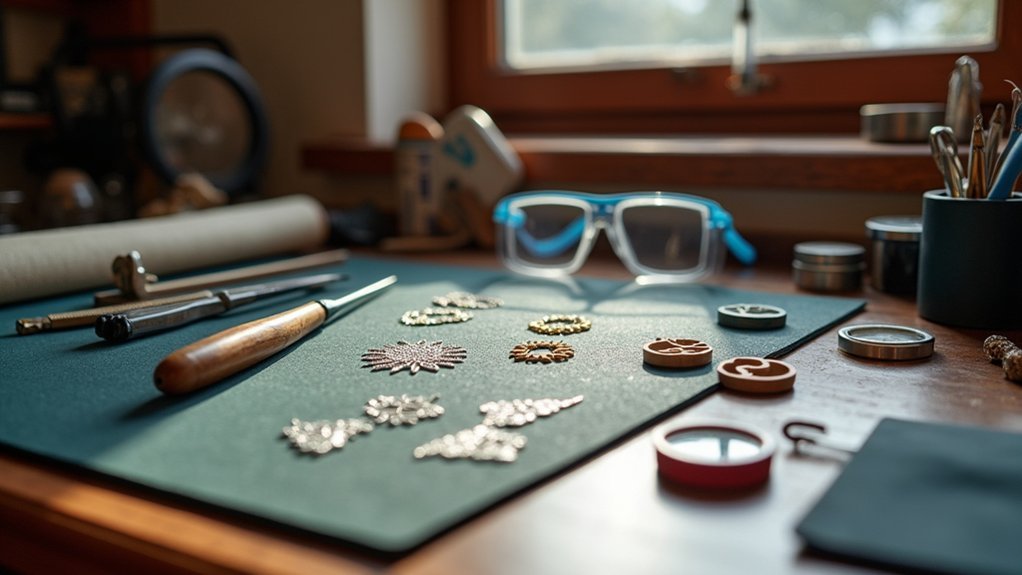You’ve experienced the frustration of fasteners that fail when you need them most. In 2025, professional-grade riveting tools have evolved to deliver connections that simply won’t quit. From automotive repairs to metalwork projects, the right riveting tool transforms your work from amateur to expert-level. We’ve tested dozens of models across various applications and materials to identify the five standouts that deserve a place in your workshop. The results might surprise you.
Rivet Nut Tool Kit with 15 Mandrels and 182pcs Rivnuts
The NOVORIK Rivet Nut Tool Kit stands out as a thorough solution for DIY enthusiasts who need versatility without sacrificing quality. With 15 mandrel sizes and 182 rivet nuts housed in a durable carrying case, you’ll tackle projects requiring both metric and SAE connections.
The ergonomic design reduces effort by 20% compared to standard rivnut tools, making it accessible for users of all strengths. Its chromium steel core and heat-treated carbon steel handles guarantee durability, while the TPR rubber coating provides comfortable grip. The tool-free mandrel replacement system saves time, allowing you to switch between sizes quickly during multi-stage projects.
Best For: DIY enthusiasts, mechanics, and professionals seeking a comprehensive rivet nut installation tool with multiple mandrel sizes for both metric and SAE fastening applications.
Pros:
- Includes 15 different mandrel sizes (covering both metric and SAE standards) and 182 rivet nuts, providing exceptional versatility for various projects
- Ergonomic design with 20% effort reduction compared to standard tools, making it accessible for users of all strength levels
- High-quality construction with chromium steel core, heat-treated carbon steel handles, and comfortable TPR rubber grip for durability and comfort
Cons:
- At 7.98 pounds, the tool kit may be relatively heavy for those who need maximum portability
- Some users have reported concerns about specific mandrel durability and replacement part availability
- The February 2025 release date suggests this is a newer product that may not have extensive long-term reliability data
Rivet Press Machine with 5 Sets Single Cap Rivets Die (5-12mm)
Crafters who work with leather, fabric, and other materials will find exceptional versatility in this Turkish-made DZNTOOLS press machine. This aluminum hand press weighs just 4.1 pounds but delivers professional results across multiple applications.
You’ll receive five different sized rivet dies (5mm-12mm), a 2mm hole puncher, and a brass base—everything needed to start riveting immediately. Beyond rivets, this universal tool also sets snaps, grommets, eyelets, and buttons.
With its 4.6-star rating, this press machine offers excellent value for DIY enthusiasts and professionals who need reliable performance for leathercraft, garment work, and accessory creation.
Best For: DIY leatherworkers, craft enthusiasts, and small business owners creating custom bags, belts, garments, and accessories who need a versatile, affordable riveting solution.
Pros:
- Comprehensive kit includes five different rivet die sizes (5-12mm) and a hole puncher, eliminating the need for separate purchases
- Versatile aluminum press works with multiple fastener types beyond rivets, including snaps, grommets, eyelets, and buttons
- Lightweight design (4.1 pounds) makes it portable while still providing professional-quality results for leather and fabric projects
Cons:
- Limited to smaller rivets (max 12mm), which may not be sufficient for heavy-duty industrial applications
- Being a manual press, it requires physical effort and may cause hand fatigue during large production runs
- Relatively new product (available since May 2023) with limited customer reviews to verify long-term durability
Hand Rivet Nut Tool Professional Kit with 13 Mandrels and 125 Rivets
Serious DIYers and professionals seeking versatility will find exceptional value in the Hand Rivet Nut Tool Professional Kit. The 16-inch carbon steel construction delivers impressive leverage for tough applications from automotive repairs to furniture assembly.
You’ll appreciate the tool-free quick-change system with 13 mandrels covering both metric and SAE sizes. The kit includes 125 rivet nuts to get you started immediately.
With a 4.6-star rating from nearly 900 reviewers, users consistently praise its performance for Jeep modifications, heat pump installations, and more. While no case is included, the durability and extensive sizing options make this a workshop essential.
Best For: DIY enthusiasts and professionals requiring a versatile rivet nut setter tool for automotive repairs, furniture assembly, off-road modifications, and various metal fastening applications.
Pros:
- Comprehensive kit includes 13 interchangeable mandrels (7 metric and 6 SAE sizes) and 125 rivet nuts to handle a wide range of project requirements
- Tool-free quick-change head design allows for effortless switching between different mandrel sizes, saving time during multi-size projects
- 16-inch carbon steel construction with ergonomic handles provides excellent leverage and durability for consistent performance
Cons:
- No carrying case included, requiring users to find their own storage solution for the tool and its various components
- Some users reported issues with specific mandrel sizes, suggesting potential inconsistency across the full range
- Requires proper technique and alignment during operation to avoid tool damage, with a learning curve for first-time users
Rivet Nut Tool Kit (520pcs SAE & Metric Assortment)
For DIY enthusiasts and professionals needing extensive fastening options, this Rivet Nut Tool Kit delivers exceptional value with its massive 520-piece assortment. You’ll find both metric (M3-M10) and SAE (#6-32 to 3/8-16) sizes, covering virtually any project requirement.
The galvanized carbon steel rivets feature work-hardened surfaces and precision threading, ensuring corrosion resistance and durability in applications ranging from automotive to furniture assembly. Their knurled body design prevents rotation once installed.
While the thorough selection impresses most users, some report issues with the storage box dividers separating during shipping, causing size mix-ups.
Best For: DIY enthusiasts and professionals who need a comprehensive selection of rivet nuts for various projects across automotive, furniture, and home improvement applications.
Pros:
- Extensive 520-piece collection includes both metric and SAE sizes, providing versatility for nearly any fastening need
- Galvanized carbon steel construction with work-hardened surfaces ensures durability and corrosion resistance
- Knurled body design prevents rotation once installed, creating secure and reliable connections
Cons:
- Storage box dividers may separate during shipping, resulting in mixed-up sizes and organization challenges
- Some customers report receiving fewer pieces than the advertised 520-piece count
- Requires proper hole drilling and preparation for optimal installation, which may be challenging for beginners
Tusk Chain Riveting Tool Heavy Duty
Motorcycle enthusiasts tackling chain maintenance will appreciate the Tusk Chain Riveting Tool Heavy Duty as a workshop essential. Designed specifically for 520 or larger chains, this robust tool effectively rivets links for endless chains while also capable of breaking smaller chains by pushing pins out.
Weighing 2.58 pounds with dimensions of 9 x 5.25 x 2.25 inches, it’s built for durability. Users consistently praise its effectiveness and value, though proper alignment is recommended during operation. For best results, grind down rivet heads before use and maintain the tool with regular oiling. At 4.1/5 stars, it’s a reliable addition to your motorcycle maintenance toolkit.
Best For: Serious motorcycle enthusiasts and mechanics who regularly perform chain maintenance on off-road and street motorcycles with 520 or larger chains.
Pros:
- Heavy-duty construction that handles the rigors of frequent chain work
- Versatile functionality for both riveting endless chains and breaking smaller chains
- Good value for money compared to professional shop tools
Cons:
- Some users report missing pieces or components upon delivery
- Requires careful alignment during use to avoid damaging chain links
- May need additional preparation (like grinding down rivet heads) for optimal performance
Factors to Consider When Choosing Riveting Tools That Create Secure Connections
When shopping for riveting tools that’ll guarantee secure connections, you’ll need to evaluate the tool’s construction quality and handle length for proper leverage. You should also check the mandrel selection range to confirm compatibility with your project’s rivet sizes and the tool’s overall weight if portability matters to your work situation. Consider each tool’s material compatibility specifications to guarantee it’ll effectively handle aluminum, steel, or other specific materials you’re working with.
Tool Construction Quality
The construction quality of your riveting tool determines both its performance and longevity. Look for tools crafted from premium materials like carbon steel or chromium steel, which provide exceptional durability during intense use and resist wear over time.
Pay attention to ergonomic design elements, particularly soft rubber-coated handles that reduce fatigue during extended projects. This comfort feature isn’t just about convenience—it directly impacts your work quality on lengthy jobs.
Weight is another important consideration. Heavier tools (typically measured in pounds) offer greater stability and leverage, resulting in more consistent rivet placement. Additionally, tools with robust construction guarantee uniform compression of rivet nuts, creating stronger connections.
For maximum efficiency, prioritize models with tool-free mandrel replacement systems, which minimize downtime and keep your workflow smooth through complex projects.
Handle Length Considerations
Selecting the ideal handle length for your riveting tool directly impacts both efficiency and user comfort during projects. The standard 16-inch handle provides approximately 20% less effort requirement compared to shorter options, giving you better mechanical advantage when securing connections.
You’ll find that longer handles deliver superior torque application, making them excellent choices for demanding automotive and industrial applications where strength is paramount. This increased leverage translates to more secure fastening with less physical strain.
However, you’ll need to balance your need for leverage against workspace constraints. While extended handles reduce fatigue during repetitive tasks, especially when paired with ergonomic designs, they may limit maneuverability in confined areas. Consider your typical working environment when choosing between maximum leverage and accessibility to guarantee peak performance for your specific applications.
Mandrel Selection Range
Because reliable connections depend heavily on proper sizing, a thorough mandrel selection range stands as perhaps the most critical feature in quality riveting tools. The best tools in 2025 offer extensive options spanning from M3 to M12 (metric) and #6-32 to 1/2-13 (SAE), guaranteeing you’re equipped for virtually any application.
When evaluating riveting tools, prioritize those with tool-free mandrel changing capabilities, as this dramatically improves workflow efficiency. You’ll appreciate the time saved when shifting between different rivet sizes during complex projects.
Remember that proper mandrel selection directly impacts connection security—the right size guarantees uniform compression and peak load distribution. By choosing a kit with all-encompassing mandrel options, you’ll avoid frustrating mid-project purchases and consistently achieve professional-grade results across various materials and thicknesses.
Weight and Portability
When working on extended projects that demand numerous rivets, your tool’s weight becomes a crucial factor in preventing fatigue and maintaining precision. Most riveting tools on the market weigh between 2.58 and 7.98 pounds—lighter options are ideal for prolonged use, while heavier tools might offer more durability at the expense of comfort.
You’ll want to reflect on both dimensions and overall design. Compact tools maneuver more easily in tight spaces, improving your efficiency and access to difficult areas. For professionals who travel between job sites, portability extends beyond just the tool itself—look for options that include a rugged carrying case to keep all components organized and protected. The best riveting tools strike the perfect balance between substantial build quality and manageable weight for all-day use.
Material Compatibility Specs
The right riveting tool must match your project’s material requirements to create secure, lasting connections. Consider the rivet nut material—galvanized carbon steel offers excellent corrosion resistance while maintaining load-bearing strength for demanding applications.
Size compatibility is vital; make certain your tool accommodates the specific dimensions needed for your project, whether metric (M3-M12) or SAE (#6-32 to 1/2-13). The material strength of your rivets directly impacts connection durability, with high-strength carbon steel providing superior performance in heavy-duty scenarios.
Always evaluate the thickness and hardness of materials being joined—some tools excel with thinner substrates while others are engineered for robust materials. Remember that application-specific tools exist; don’t use a tool designed for lightweight materials like leather when working with heavy metal components.
Application-Specific Requirements
Selecting application-specific riveting tools strengthens your project’s integrity beyond just material compatibility. You’ll need automotive-grade riveters for vehicle repairs, where vibration and stress demand exceptional joint stability. For fabric applications, choose lighter models with specialized mandrels that won’t damage delicate materials while maintaining secure connections.
Industrial environments require heavy-duty tools constructed from chromium or reinforced carbon steel that withstand repeated use under demanding conditions. Look for models offering mandrel sizes from M3 to M12 (or equivalent SAE sizes) to handle various material thicknesses without switching tools.
Don’t overlook ergonomics—comfort features become essential during prolonged use. Tool-free mandrel replacement systems minimize downtime when switching between rivet types. Your efficiency and the quality of your connections depend on matching the right specialized tool to your specific application requirements.
Storage Organization Features
Proper storage organization features often distinguish professional-grade riveting kits from amateur options, directly impacting your workflow efficiency and connection quality. When evaluating riveting tools, look for transparent storage cases that allow you to quickly identify the components you need without wasting time searching.
The best kits include well-designed dividers that prevent rivet nuts and mandrels from mixing during transport, eliminating size confusion when you’re ready to work. This organization is especially essential for kits with multiple mandrel sizes.
You’ll also want lightweight, portable storage solutions that make it easy to bring your riveting tools to any job site. Beyond convenience, proper organization protects your investment by reducing wear and tear from disorganized handling, ultimately extending the lifespan of your riveting components.
Effort-Saving Mechanisms
Effort-saving mechanisms represent the next frontier in riveting tool evolution, offering tangible benefits beyond just storage convenience. The best tools of 2025 incorporate internally-positioned levers and extended handles that reduce required effort by approximately 20% compared to traditional designs.
You’ll appreciate ergonomic features that enhance comfort and leverage, making these tools suitable regardless of your age or strength level. Look for quick-change mechanisms for mandrels and nosepieces that eliminate the need for additional tools, dramatically improving your efficiency.
High-quality materials like heat-treated carbon steel guarantee durability while minimizing physical strain during use. When selecting your riveting tool, prioritize these effort-saving features—they consistently correlate with higher user satisfaction and superior performance across applications. The right ergonomic design makes professional-grade connections achievable without excessive physical exertion.
Frequently Asked Questions
How Do I Maintain Riveting Tools for Longer Lifespan?
To maintain your riveting tools longer, clean them after each use, lubricate moving parts regularly, store in dry places, avoid overloading beyond capacity, and replace worn components promptly. You’ll considerably extend their operational lifespan.
Can Riveting Tools Be Used on Thin or Delicate Materials?
Yes, you can use riveting tools on thin or delicate materials, but you’ll need to select smaller rivets and apply gentle pressure. Consider using pop rivets specifically designed for lightweight applications to prevent damage.
What Safety Equipment Should I Wear When Using Riveting Tools?
When using riveting tools, you’ll need safety glasses to protect your eyes, gloves to prevent hand injuries, and ear protection for noisy pneumatic riveters. Don’t forget proper footwear and fitted clothing that won’t catch.
Are Battery-Powered Riveting Tools as Effective as Manual Ones?
Yes, battery-powered riveting tools are typically more effective than manual ones. You’ll get consistent results with less effort. They’re faster, provide uniform pressure, and reduce hand fatigue during larger projects.
How Do I Fix a Rivet That Wasn’t Properly Installed?
To fix an improperly installed rivet, you’ll need to drill it out with a bit slightly larger than the rivet shaft. Then clean the hole, and install a new rivet correctly using proper technique and sizing.





Leave a Reply